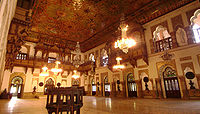- Laxmi Vilas Palace, Vadodara
-
The term Maharaja Palace actually refers to a series of palaces in Vadodara, India, constructed since the Gaekwad a prominent Maratha family started ruling the Vadodara State. The first one was a building known as the Sarkar Wada. This building, not really a palace, was given up for the Nazarbaug Palace built in old classical style.
After this the Lakshmi Vilas Palace, an extravagant building of the Indo-Saracenic school, was built by Maharaja Sayajirao Gaekwad III in 1890 at a cost of GBP180,000. Major Charles Mant was the architect.
It is reputed to have been the largest private dwelling built till date and four times the size of Buckingham Palace. At the time of construction it boasted the most modern amenities such as elevators and the interior is reminiscent of a large European country house. It remains the residence of the Royal Family, who continue to be held in high esteem by the residents of Baroda.
Its ornate Darbar Hall, which is sometimes the venue of music concerts and other cultural events, has a Venetian mosaic floor, Belgium stained glass windows and walls with intricate mosaic decorations. Outside of the Darbar Hall is an Italinate courtyard of water fountains. The palace houses a remarkable collection of old armoury and sculptures in bronze, marble & terracotta by Fellici. The grounds were landscaped by William Goldring, a specialist from Kew Gardens. The palace is open to the public and an audio tour is available.
The Palace "compound" is of over 700 acres (2.8 km2) and houses a number of buildings, particularly the Moti Baug Palace and the Maharaja Fateh Singh Museum building. Adjacent to the Motibaug Palace and the Museum is the Moti Bagh Cricket Ground, the offices of the Baroda Cricket Association, and a very rare indoor teak floored tennis court and badminton court (where the All India Badminton Championships were previously held). There are also two clay tennis courts plus a derelict fives court.
The Museum building was constructed as a school for the Maharaja's children. Today a large number of works of art belonging to the Royal family have been displayed in the museum. The most remarkable of these is the fabulous collection of the paintings of Raja Ravi Varma, who was specially commissioned by the then Maharaja of Baroda. The collection includes portraits of the Royal family in addition to the paintings based on Hindu mythology for which Raja Ravi Varma was famous.
The Maharaja constructed a miniature railway line, which circled the mango orchard within the palace compound, to take his children from the school to the main Lakshmi Vilas Palace. The train engine was recently refurbished by Ranjitsinh Pratapsinh Gaekwad, the current maharaja, and can be seen at the entrance to the Museum.
The palace also boasted a small zoo. The only remnant of the zoo is the pond where a number of crocodiles remain. The Navlakhi (literally meaning "of nine hundred thousand") Well, a fine 'baoli' or step well, is 50 metres north of the palace.
In the 1930s Maharaja Pratapsinh created a golf course for use by his European guests. In the 1990s Pratapsinh's grandson Samarjitsinh, a former Ranji trophy cricket player, renovated the course and opened it to the public. The course was expanded in 2004 into a beautiful course managed by the Gaekwad Baroda Golf Club and now boasts over 300 members. The Motibaug Palace is now the club house for the club, behind which are a large new swimming pool designed by the renowned architect Karan Grover, sauna and gym facilities. Packs of langoors & peacocks can be spotted around the palace compound. The present management of the club have used the old British spelling Lukshmi Vilas Palace instead of the better known Lakshmi Vilas Palace.
Two other palaces in Baroda were the Makarpura Palace, built on the southern outskirts of Baroda which now houses a defence installation and Pratap Vilas Palace, which houses the prestigious Railway Staff College of India.References
External links
Categories:- Royal residences in India
- Visitor attractions in Vadodara
- Palaces in Gujarat
- Baroda State
Wikimedia Foundation. 2010.




